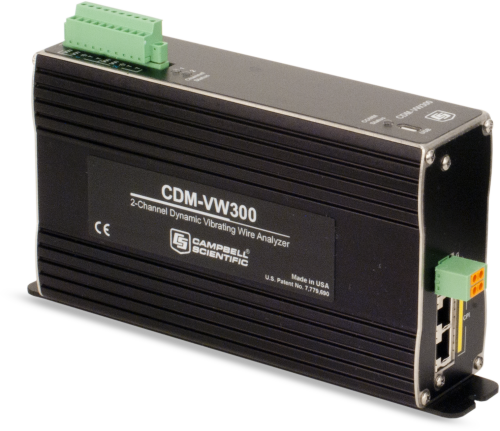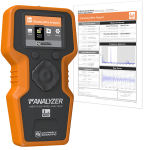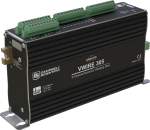This product is not available for new orders. We recommend ordering: VWIRE305.

| Services Available |
|---|
Überblick
Das CDM-VW300 ist ein zweikanaliges Interface zwischen Sensor und Datenlogger, das kürzere Abstände zwischen den Messungen ermöglicht. Das Interface reduziert das Rauschen, das häufig bei Schwingsaitensensoren auftritt. Es ermöglicht es, dass das Signal durch längere Kabel dringt und damit mehr Flexibilität bei der Aufstellung von Sensoren und Datenloggern.
Das CDM-VW300 kann mit Standard-Schwingsaitensensoren verwendet werden und ermöglicht schnellere und genauere Messungen ohne dass neue Sensoren gekauft werden müssen.
Mehrere CDM-VW300s können an einem Logger angeschlossen werden.
Das CDM-VW305 ist ein ähnliches Modul mit 8 Kanälen.
Diese Module nutzen die patentierte Schwingsaiten-spektralanalysetechnik (VSPECT) um die Resonanzfrequenz der Schwingsaite zwischen den Anregungen zu bestimmen. Dadurch ergibt sich eine sehr feine Auflösung während externe Störungen weniger Einfluss haben. Es kann zwischen Signal und Rauschen aufgrund des Frequenzanteils unterschieden werden.

Funktionen und Vorteile
- Interfaces to standard single-coil vibrating wire sensors
- Two simultaneously sampled channels per module; synchronizable across multiple modules
- Dynamic measurement rates of 20 to 333 Hz
- Static measurement at 1 Hz made simultaneously with the dynamic measurement
- Spectral interpolation approach provides superior noise immunity and measurement resolution compared to time-domain period-averaging approach
- Excitation method provides frequent low-energy pulses to maintain a continuous resonant vibration in the sensor
- Thermistor input for each vibrating wire channel is sampled at 1 Hz
- Data logger communications via CPI
- User-configurable, onboard post-processing of the data including frequency output conversion, temperature conversion, and rainflow histogram collection
Bilder



Zugehörige Produkte
Technische Beschreibung
In addition to the dynamic vibrating wire measurement, the CDM-VW300 makes several auxiliary measurements. A static vibrating wire measurement is made once each second, along with the dynamic measurements, which provides finer measurement resolution and greater immunity to external noise sources. The CDM-VW300 includes a thermistor input channel paired with each vibrating wire channel, featuring high-precision 24-bit measurements at a 1 Hz rate. Lastly, a rich set of diagnostic parameters is provided with the vibrating wire data.
The CDM-VW300 has the capability to simplify post-processing of data by computing common values internally. Vibrating wire data can be reported as measured frequency or as the frequency squared with a multiplier and offset applied. The thermistor data is reported as resistance or is converted to degrees Celsius using the thermistor’s Steinhart-Hart coefficients. The CDM-VW300 also can internally compile rainflow histograms from the final data and report the values at user-specified intervals.
Vibrating Wire Inputs
Each channel has two terminals for connecting to the coil of the vibrating wire sensor. Both vibrating wire terminals are labeled VW and the polarity of the wiring is arbitrary. The sensor is excited and measured through the same connections. Sinusoidal excitation is applied for a few cycles of the wire oscillation. The wire is maintained in a continuously vibrating state. Excitation voltage varies automatically to maintain the desired return signal strength.
Thermistor Inputs
Each channel has two terminals for connecting to the thermistor. Both thermistor terminals are labeled T and the polarity of the wiring is arbitrary. The measurement is a half-bridge configuration with the excitation circuitry and completion resistor integrated into the module.
Kompatibel mit
Please note: The following shows notable compatibility information. It is not a comprehensive list of all compatible products.
Datenlogger
| Product | Compatible | Note |
|---|---|---|
| CR1000 (retired) | ||
| CR200X (retired) | ||
| CR216X (retired) | ||
| CR3000 | ||
| CR6 | ||
| CR800 (retired) | ||
| CR850 (retired) | ||
| CR9000X (retired) |
Miscellaneous
| Product | Compatible | Note |
|---|---|---|
| GRANITE 9 |
Additional Compatibility Information
Data Logger Considerations
The SC-CPI Datalogger Serial-to-CPI Interface is required to connect the CDM-VW300 to a compatible data logger (except the CR6). A 5-conductor cable connects the data logger to the SC-CPI, and an Ethernet cable connects the SC-CPI to the CDM-VW300.
Multiplexers
The CDM-VW300 is not designed to work with multiplexers.
Spezifikationen
| -NOTE- | Electrical specifications are valid over a -25° to +50°C range unless otherwise specified. Non-condensing environment required. |
| Scan Rates | 20, 50, 100 Hz |
| CPI Baud Rate | Selectable from 25 kbps to 1 Mbps |
| Input Resistance | 5 kΩ |
| Excitation Voltage Range | 0 to ±3 V (6 V peak-to-peak) |
| Excitation Voltage Resolution | 26 mV |
| Operating Temperature Range |
|
| Measurement Frequency Accuracy | ±(0.005% of reading + measurement resolution) |
| Sustained Input Voltage without Damage | -0.5 to +7.1 V |
| USB | USB 2.0 full speed connection is available for attaching the device to a PC. (This port is provided to configure the module, send updates, and communicate with the Dynamic Vibrating Wire Toolbox software. The USB port is not provided for use within a permanent data collection system.) |
| CPI | Used for connection to the data logger. Baud rate selectable from 50 kbps to 1 Mbps. (Allowable cable length varies depending on baud rate, number of nodes, cable quality, and noise environment, but can be as long as 2,500 ft under proper conditions.) |
| Mounting | Standard 1-in. grid (Optional DIN rail mounting available.) |
| Warranty | One year against defects in materials and workmanship |
| Dimensions | 20.3 x 12.7 x 5.1 cm (8 x 5 x 2 in.) |
Measurement Resolution at Sample Rates |
|
| -NOTE- | Typical values for a 2.5 kHz resonant sensor |
| 1 Hz Sample Rate | 0.005 Hz RMS (noise level) |
| 20 Hz Sample Rate | 0.008 Hz RMS (noise level) |
| 50 Hz Sample Rate | 0.015 Hz RMS (noise level) |
| 100 Hz Sample Rate | 0.035 Hz RMS (noise level) |
| 200 Hz Sample Rate | 0.11 Hz RMS (noise level) |
| 333.3 Hz Sample Rate | 0.45 Hz RMS (noise level) |
Sensor Resonant Frequency Range |
|
| 20 Hz Sample Rate |
|
| 50 Hz Sample Rate |
|
| 100 Hz Sample Rate |
|
Thermistor |
|
| Completion Resistor | 4.99 kΩ 0.1% |
| Excitation Voltage | 1.5 V |
| Resolution | 0.002 Ω RMS (@ 5 kΩ thermistor resistance) |
| Accuracy | 0.15% of reading (Thermistor accuracy and resistance of the wire should be considered as additional errors.) |
| Measurement Rate | 1 Hz |
Power Requirements |
|
| Voltage | 9.6 to 32 Vdc |
| Typical Current Drain | 115 mA (@ 12 Vdc) |
Dokumente
Broschüren Produkte
Handbücher
Realisierte Projekte
Videos & Tutorials
Downloads
CDM-VW300 Example Programs (45.4 KB) 23-05-2013
CRBasic program examples for use with the CDM-VW300 and CDM-VW305.
CPI Calculator v.1.0 (2.49 MB) 06-07-2016
The CPI Calculator is a downloadable Microsoft Excel spreadsheet used to estimate the usage and capacity of a CPI network. The calculator provides an overview on CPI devices including the CDM-A108, CDM-A116, CDM-VW300, CDM-VW305, and the CSAT3B. The calculator can also estimate the measurement speed of the CDM-A108 and CDM-A116 based on the number of channels and measurement parameters.
The CPI Calculator is an estimation tool and will help you better understand and design CPI networks by considering the following:
- What is the capability of each CDM or CPI device
- What is the CPI network capacity
- How much of the CPI capacity are the CDMs or CPI devices using
DVW Tool Box v.1.3 (13.4 MB) 04-11-2019
DVW Tool Box is an application-specific software tool for demonstration and evaluation of the CDM-VW300, CDM-VW305 and VWire 305 dynamic vibrating wire interfaces.
Device Configuration Utility v.2.32.01 (47.7 MB) 15-04-2025
A software utility used to download operating systems and set up Campbell Scientific hardware. Also will update PakBus Graph and the Network Planner if they have been installed previously by another Campbell Scientific software package.
Supported Operating Systems:
Windows 11 or 10 (Both 32 and 64 bit)
CR800 OS v.32.07 (4.41 MB) 15-05-2024
Execution of this download installs the CR800 Operating System and Compiler on your computer. It also updates the CR800 support files for the CRBasic Editor.
Note: This OS has crossed the 2 Meg CR800 size limit for remote download. The OS must be downloaded to the 2 Meg CR800 via direct connect with the Device Configuration Utility. All OS download methods are supported by the 4 Meg CR800.
Upgrading from versions prior to version 28 of the Operating System will reset the datalogger’s CPU drive. This is due to a change in the format of the file system from FAT16 to FAT32. In order for the datalogger to operate correctly, as part of the upgrade, the CPU drive is formatted to FAT32. Any programs stored and running from the CPU drive will be lost. It is not recommended to update the datalogger’s Operating System over a remote connection where program control regulates the communication equipment (turning it on or off, etc.). In these cases, an on-site visit and a backup using DevConfig’s backup utility is necessary to update the datalogger’s Operating System.
Watch the Video Tutorial: Sending an OS to a Local Datalogger.
In all cases where the datalogger is being updated from an Operating System prior to 28, the use of DevConfig’s backup utility is recommended due to the CPU drive being formatted using the new FAT32 format.
CR3000 OS v.32.07 (4.39 MB) 15-05-2024
Execution of this download installs the CR3000 Operating System and Compiler on your computer. It also updates the CR3000 support files for the CRBasic Editor.
Note: The Device Configuration Utility is used to upload the included operating system to the datalogger.
Upgrading from versions prior to version 28 of the Operating System will reset the datalogger’s CPU drive. This is due to a change in the format of the file system from FAT16 to FAT32. In order for the datalogger to operate correctly, as part of the upgrade, the CPU drive is formatted to FAT32. Any programs stored and running from the CPU drive will be lost. It is not recommended to update the datalogger’s Operating System over a remote connection where program control regulates the communication equipment (turning it on or off, etc.). In these cases, an on-site visit and a backup using DevConfig’s backup utility is necessary to update the datalogger’s Operating System.
Watch the Video Tutorial: Sending an OS to a Local Datalogger.
In all cases where the datalogger is being updated from an Operating System prior to 28, the use of DevConfig’s backup utility is recommended due to the CPU drive being formatted using the new FAT32 format.
FAQs für
Number of FAQs related to CDM-VW300: 8
Alle anzeigenWenige anzeigen
-
The CDM-VW300 offers two channels for simultaneous reading of two vibrating wire sensors, whereas the CDM-VW305 offers eight channels for simultaneous measurements. Other than the number of channels supported, both models operate identically.
-
These devices work with vibrating wire strain gages, load cells, pressure transducers, crackmeters, and tiltmeters. Any standard, single-coil circuit vibrating wire sensor should work with these devices.
-
The frequency outputs generated by the CDM-VW300 or CDM-VW305 can be scaled with known sensor response functions, which are provided by the manufacturer of the sensor. These frequency conversions are used to obtain measurement outputs expressed in the desired engineering units.
-
Yes. When more than eight channels are needed in a system, multiple CDM-VW300-series devices can be connected to the same data logger.
- Each CDM-VW300 device provides two terminals.
- Each CDM-VW305 device provides eight terminals.
Any combination of CDM-VW300 and CDM-VW305 devices can be used to achieve the desired number of total terminals.
The list below, ordered by data logger and measurement rate, indicates the maximum number of supported terminals:
- CR3000, 100 Hz: 8 terminals
- CR3000, 50 Hz: 24 terminals
- CR3000, 20 Hz: 48 terminals
- CR1000, 100 Hz: not supported
- CR1000, 50 Hz: 8 terminals
- CR1000, 20 Hz: 32 terminals
- CR800-series, 100 Hz: not supported
- CR800-series, 50 Hz: 8 terminals
- CR800-series, 20 Hz: 32 terminals
-
To communicate with CDM devices using the CPI protocol, the CR3000, CR1000, CR850, and CR800 dataloggers require an SC-CPI device. Only one SC-CPI device per datalogger is required. It is expected that the design of future Campbell Scientific datalogger products will work with CPI-based modules directly.
-
The communications protocol used by CDM devices is the CAN Peripheral Interface (CPI), which includes methods that are proprietary to Campbell Scientific.
-
Yes. Specific types of sensor measurements can be examined and evaluated before the system is deployed to a field site. A data logger is not used for this type of evaluation. Connect the CDM-VW300-series device directly to a computer using a USB cable. Using DVWTool software (specialized software included with the CDM-VW300 or CDM-VW305), the outputs of the attached vibrating wire sensors can be observed, and the CDM device can be configured appropriately.
-
CDM-VW300-series devices can measure vibrating wire sensors at the following rates: 1 Hz, 20Hz, 50Hz, 100Hz, 200Hz, and 333.3 Hz. CDM-VW300-series devices are designed for measurement periods of 1 s or less.


